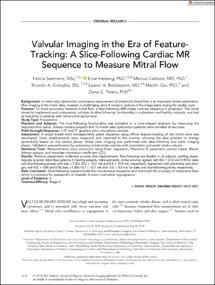Mostrar el registro sencillo del ítem
Valvular imaging in the era of feature-tracking: A slice-following cardiac MR sequence to measure mitral flow
| dc.contributor.author | Seemann, Felicia | |
| dc.contributor.author | Heiberg, Einar | |
| dc.contributor.author | Carlsson, Marcus | |
| dc.contributor.author | Gonzales, Ricardo A. | |
| dc.contributor.author | Baldassarre, Lauren A. | |
| dc.contributor.author | Qiu, Maolin | |
| dc.contributor.author | Peters, Dana C. | |
| dc.date.accessioned | 2021-03-16T23:23:01Z | |
| dc.date.available | 2021-03-16T23:23:01Z | |
| dc.date.issued | 2019-10-25 | |
| dc.identifier.issn | 1522-2586 | es_PE |
| dc.identifier.uri | https://hdl.handle.net/20.500.12815/192 | |
| dc.description.abstract | Background: In mitral valve dysfunction, noninvasive measurement of transmitral blood flow is an important clinical examination. Flow imaging of the mitral valve, however, is challenging, since it moves in and out of the image plane during the cardiac cycle. Purpose: To more accurately measure mitral flow, a slice-following MRI phase contrast sequence is proposed. This study aimed to implement such a sequence, validate its slice-following functionality in a phantom and healthy subjects, and test its feasibility in patients with mitral valve dysfunction. Study Type: Prospective. Phantom and Subjects: The slice-following functionality was validated in a cone-shaped phantom by measuring the depicted slice radius. Sixteen healthy subjects and 10 mitral valve dysfunction patients were enrolled at two sites. Field Strength/Sequence: 1.5T and 3T gradient echo cine phase contrast. Assessment: A single breath-hold retrospectively gated sequence using offline feature-tracking of the mitral valve was developed. Valve displacements were measured and imported to the scanner, allowing the slice position to change dynamically based on the cardiac phase. Mitral valve imaging was performed with slice-following and static imaging planes. Validation was performed by comparing mitral stroke volume with planimetric and aortic stroke volume. Statistical Tests: Measurements were compared using linear regression, Pearson's R, parametric paired t-tests, Bland–Altman analysis, and intraclass correlation coefficient (ICC). Results: Phantom experiments confirmed accurate slice displacements. Slice-following was feasible in all subjects, yielding physiologically accurate mitral flow patterns. In healthy subjects, mitral and aortic stroke volumes agreed, with ICC = 0.72 and 0.90 for static and slice-following planes; with bias ±1 SDs 23.2 ± 13.2 mls and 8.4 ± 10.8 mls, respectively. Agreement with planimetry was stronger, with ICC = 0.84 and 0.96; bias ±1 SDs 13.7 ± 13.7 mls and –2.0 ± 8.8 mls for static and slice-following planes, respectively. Data Conclusion: Slice-following outperformed the conventional sequence and improved the accuracy of transmitral flow, which is important for assessment of diastolic function and mitral regurgitation. | es_PE |
| dc.format | application/pdf | es_PE |
| dc.language.iso | eng | es_PE |
| dc.publisher | Wiley | es_PE |
| dc.rights | info:eu-repo/semantics/openAccess | es_PE |
| dc.rights.uri | http://creativecommons.org/licenses/by-nc-nd/4.0/ | * |
| dc.source | Repositorio Institucional UTEC | es_PE |
| dc.source | Universidad de Ingeniería y Tecnología - UTEC | es_PE |
| dc.subject | Mitral valve flow | es_PE |
| dc.subject | Slice‐following | es_PE |
| dc.subject | Cardiovascular magnetic resonance | es_PE |
| dc.subject | Phase contrast | es_PE |
| dc.subject | Feature‐tracking | es_PE |
| dc.title | Valvular imaging in the era of feature-tracking: A slice-following cardiac MR sequence to measure mitral flow | es_PE |
| dc.type | info:eu-repo/semantics/article | es_PE |
| dc.identifier.doi | https://doi.org/10.1002/jmri.26971 | es_PE |
| dc.identifier.journal | Journal of Magnetic Resonance Imaging | es_PE |


